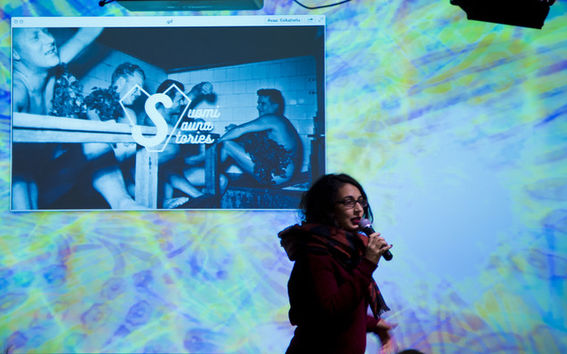New uses for cultural materials

The culturally-themed Hack4FI – Hack your heritage hackathon was held at Aalto Media Factory on 5–7 February. The purpose of the event is to create new products, services and concepts from the open digital materials at museums and memory organisations.
Open digital cultural materials can be photographs, videos, newspaper articles, maps, sound, architectural images, as well as statistics and numerical metadata.
‘Hack4FI was held for the first time last year. At that time, the resulting material included games, music videos and mobile applications,' says Sanna Marttila, who is the event's project manager.
One hundred participants, half of whom were students, registered for this year's event. The diverse group of participants include designers, artists, software developers, and people from research and education. Also taking part are the museums and memory organisations that opened up their materials, such as Yle Archives, Finna search service, the National Board of Antiquities, Finnish National Gallery, and the Finnish Museum of Photography.
‘Memory and cultural organisations have an understanding of the materials and their backgrounds, but they don't necessarily possess the expertise needed to develop them into something new. I think it's a bold move for the organisations to open their materials and see what they can be turned into,' states Marttila.
Everyone has a right to cultural heritage
According to Marttila, memory and cultural organisations have digitalised a lot of material, but the materials haven't been made widely available to citizens yet.
‘The idea behind Hack4FI is that everyone has a right to memory and cultural heritage. People should have the opportunity to not only see the materials but also to use them and utilise them for new purposes.'
Sanna Hirvonen, a senior planning officer at the Museum of Contemporary Art Kiasma, took part in the event and also feels the same way. She represents the Finnish National Gallery, which along with Kiasma includes Ateneum and the Sinebrychoff Art Museum.
‘I think that providing access to the materials is one of the tasks of art institutions that are financed through public funding.'
According to Hirvonen, the Finnish National Gallery has opened a lot of materials during the past couple of years, including metadata for art collections and a variety of image materials. Metadata is, for example, information about the name, creator and year of purchase of the works of art. The image materials include photographs taken by Hugo Simberg and photos of the Kiasma museum building.
'Metadata could be used to make visualisations that highlight our materials in an interesting light. On the other hand, the photographs of the Kiasma building could be developed into an application related to tourism or architecture,' explains Hirvonen.
Work continues in the upcoming weeks
Hackathons typically last for a weekend and involve round-the-clock coding of mobile and online applications. However, the nights at Hack4FI were reserved for sleeping and there was no intention to actually produce anything during that weekend.
The Hack4FI event was only the kick-off for the actual work, as the teams put together during the event will continue to develop their ideas for several weeks.
By the end of March, the teams must have something concrete to show, such as a prototype, video or functional demo. The teams can also enter a competition, the winner of which will be announced at the Hack4FI final gala on 13 April.
Hack4FI is based on the successful Danish concept Hack4DK (hack4.dk).
Hack4FI is organised by the AvoinGLAM network (avoinglam.fi) in cooperation with Aalto University and Aalto Media Factory (mediafactory.aalto.fi). The event is funded by the Ministry of Education and Culture.
The Hack4FI:n website: http://hack4.fi/
Text: Tea Kalska
Photo: Kerttu Hakkarainen
- Published:
- Updated:
Read more news

DeployAI Partners Gather for Heart Beat Meeting in Helsinki
The European DeployAI project's partners gathered for the Heart Beat meeting hosted by Aalto University Executive Education in Helsinki.
Key Skills for Sustainability Experts: Collaboration and Communication
As industries increasingly focus on sustainability, the demand for sustainability expertise is growing. But what specific skills do employers seek in sustainability experts?Unite! Research Week in Grenoble-Autrans, 14-18 October
A networking event focusing on AI, Energy and Industry 4.0 for faculty and doctoral studentsSummmer break in HR service point and new opening hours starting from 6 August 2024
HR service point is closed on 28 June - 5 August 2024. New opening hours are tuesday - thursday at 12.00 - 15.00 starting from 6 August 2024.Please note that the opening hours will change starting from 6 August 2024.